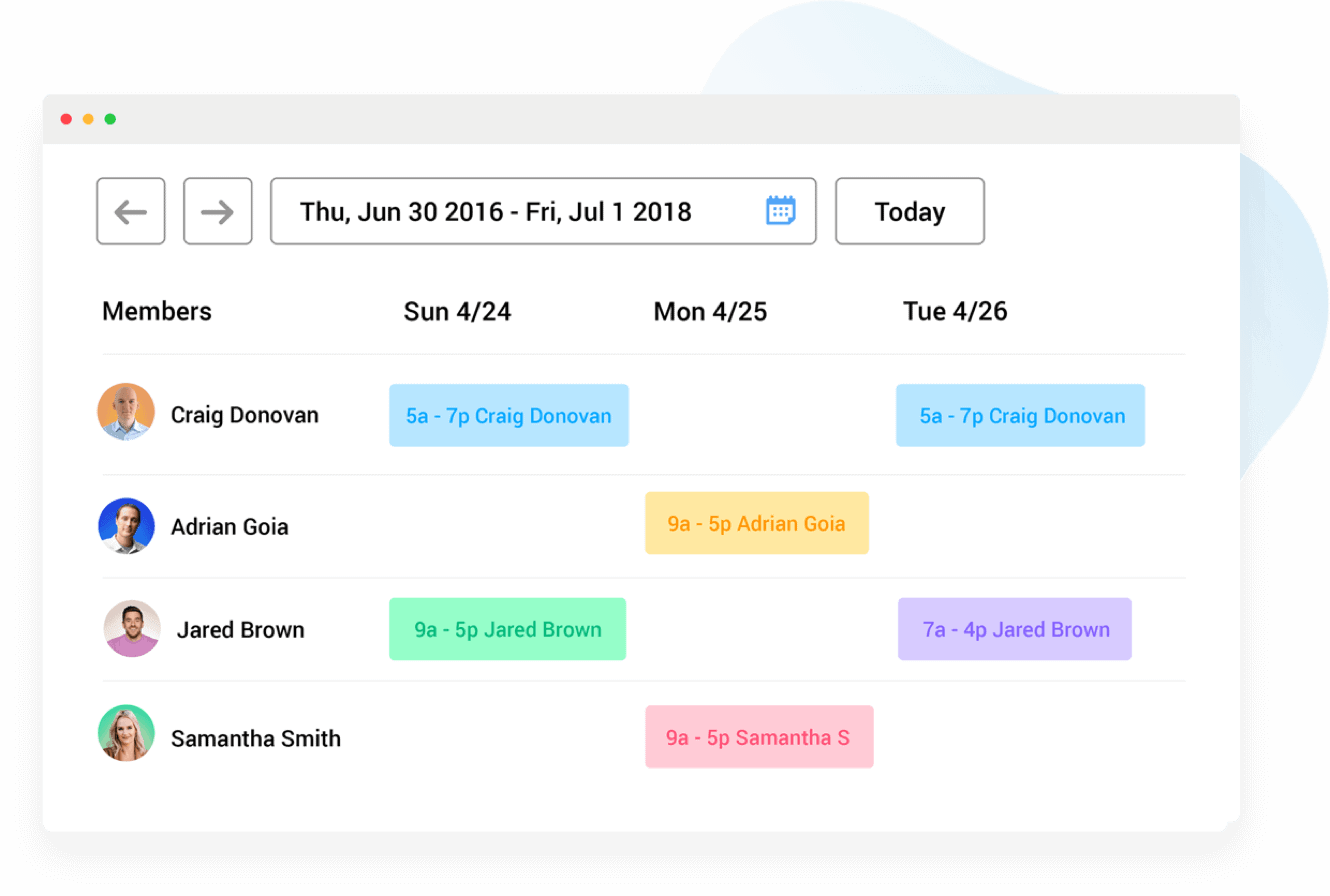Have you ever found yourself caught in an employee scheduling nightmare? Don’t worry, we get it. Life’s hectic, and scheduling issues happen.
Unfortunately, getting this wrong can be catastrophic for your team. One of the reasons employees quit their jobs is due to scheduling issues. In fact, Inc. Magazine named scheduling their 5th most common reason for quitting.
In this post, we’re tackling 15 scheduling headaches head-on. From conflicting appointments to time slips, we’ve been there.
Boost your team’s efficiency with Hubstaff's productivity tools
1. Not enough employees
It’s hard to know what the day will bring.
For example, in construction planning and scheduling, you can get to a job site and soon receive a call from an employee who has an unexpected issue.
Now, you have fewer employees scheduled than needed to complete the job on time.
Or let’s say you are unsure how to schedule retail staff because you have an unexpected influx of customers due to an event in town.

2. Double booking
Double-booking, the act of scheduling two or more commitments simultaneously, poses various challenges with far-reaching consequences. The immediate impact includes conflicts and potential disappointment among those involved.
Beyond strained relationships, consistent double-booking can erode reliability, leading to missed opportunities and heightened stress levels. In professional settings, it may result in missed client meetings or project deadlines, affecting one’s career trajectory.
3. Overscheduling
Conversely, scheduling an employee for too many hours will cause burnout and lead to quitting.
You want to maximize schedules so everyone gets the hours they want while limiting burnout and overtime.
4. Ignoring employee preferences
Accommodating individual work hours and schedule preferences adds more complexity to team scheduling. Balancing the unique needs of each team member, such as preferred start and end times or specific days off, while ensuring the team’s overall efficiency requires a delicate juggling act.
Striking this balance is crucial for maintaining employee satisfaction, morale, and productivity.
5. Unlawful scheduling
Although there are work schedule laws in specific industries to avoid burnout, not all industries require particular time off or scheduled breaks.
That means the business owner must stay up-to-date on scheduling abuse and unfair scheduling to avoid unwanted side effects.
The U.S. Department of Labor offers industry-specific resources for complying with the Wage and Hour Division. Construction companies, for example, have different regulations regarding hours.
But, finding the correct guidelines to follow can be tricky, not to mention the increasing popularity of state and city fair scheduling laws, which continue to change.
Being more consistent and fair with shifts can combat inconsistent work schedules, which can harm employees and employers.
A Workforce article describes predictive scheduling in the following way:
“The laws generally require larger employers in retail, fast food, hospitality, and other service industries to give hourly workers some advance notice of shifts and shift changes — typically seven to 14 days.
Depending on the jurisdiction, the laws may direct employers to offer additional hours to existing part-time employees before hiring new help or guarantee new employees the minimum hours they were promised when they were hired.
Some laws also direct employers to pay employees extra for last-minute schedule changes. In addition to paying back wages, laws may direct employers that fail to comply to also pay fines and, in some cases, damages.”

6. Poor overtime management
The need for overtime to meet tight deadlines or address unexpected workloads must be carefully managed. Balancing the demand for extended work hours with considerations for employee well-being and adherence to labor regulations is a delicate task.
Effective overtime management involves clear communication, monitoring employee fatigue, and ensuring fair compensation for additional hours worked.
7. No formal schedule
This sounds obvious, but if you have been in business for a while, you may rely on the same system since you began.
For example, you own a cleaning company and started the company out of your home.
You may have used a pad of paper and a pen to create a schedule you are still using today. However, tons of digital scheduling programs make scheduling issues easier.
8. Employee availability changes:
Shifts in employee availability, whether due to personal commitments, health reasons, or other unforeseen circumstances, can disrupt existing schedules.
Swift and efficient adjustments are necessary to accommodate these changes while minimizing the impact on team productivity. Proactive communication with affected team members and a flexible scheduling approach are essential for navigating such shifts.
9. Sick days and unexpected absences
Common scheduling challenges include when an employee needs to take time off.
Let’s say your employee gets sick or the school calls while at work and must leave to pick up their child early.
Life gets in the way of work, leading to work shifts needing to be shuffled around. You have a business to run but also want to be a fair manager when personal issues arise.
10. Planned time off
No employee should work without taking any breaks. On top of that, employees need vacation and personal days.
The issue is how to work these days into your schedule seamlessly. Let’s say, for example, you employ a lot of parents who all live in the same town and have the same spring break. How do you schedule when every employee requests the same week off?

11. Time zone coordination
Managing teams spread across different time zones introduces complexities in coordinating meetings and collaborative work schedules.
Overcoming the challenges of time zone differences requires strategic planning, using technology to facilitate communication, and establishing clear expectations regarding response times and availability windows.
12. Employee turnover
You try to avoid staff turnover as much as possible. Unfortunately, people leave companies, and sometimes, these are circumstances out of your control.
However, this creates substantial scheduling issues when you are left with large blocks of time without employee coverage.
13. Meeting coordination
The planning and coordination of meetings that align with the availability of all team members can be a time-consuming and challenging task. Meeting scheduling inefficiency can result in wasted time, decreased productivity, and frustration among team members.
Utilizing scheduling tools, setting clear agendas, and respecting individuals’ time constraints can help streamline this process.
14. Lack of flexibility
Rigid scheduling policies that do not account for team members’ diverse needs and preferences can lead to dissatisfaction and decreased morale. Flexibility may help employee work-life balance, talent recruitment, and retention.
Implementing more flexible scheduling options, such as remote work or flexible hours, can create a more positive work environment.
15. Training and development
Coordinating training sessions and professional development opportunities without disrupting daily operations poses a unique challenge. Striking a balance between ongoing learning and day-to-day responsibilities requires thoughtful planning and communication.
Employers must ensure that employees have access to continuous learning opportunities without compromising their ability to meet job requirements.
Employee scheduling tips to follow
Now that we’ve discussed some of the most common scheduling issues, let’s talk about managing staff scheduling for a seamless workflow.
Here are seven solutions to solve your work scheduling issues.
1. Hire enough employees
If one of your scheduling issues is you don’t have enough employees to do the job, then you need to hire more.
Sometimes, knowing how many employees you will need is hard if you are a startup. You don’t want the added expense if you are a small business.
You don’t want to drive potential customers away either by not being adequately staffed. Looking at past traffic and sales patterns is essential so you are not left scrambling to hire employees at the last minute.
2. Offer time between shifts
No one wants to be overworked.
Make sure your employees have plenty of planned breaks and time between shifts.
It’s also important to communicate this during the hiring process. Let your employees know you value company culture and that you are a team.
For example, if you are in retail and open seven days a week, give employees the same two days off per week. That way, employees have enough personal time and rest from work. Plus, a planned work week that they can follow and use to establish a routine.
3. Use a scheduling app
Common scheduling issues run across all industries, so it’s vital to have a solid system in place.
This system should be digital and easily accessible so it’s easy to schedule, track, and evaluate employee time.

For example, Hubstaff is simple scheduling software that allows you to create a schedule, track how many hours each employee has worked, and set weekly time caps so no one is overworked. Plus, it’s available as a desktop, web, or mobile app, so your schedule and time tracking are available whether you work on a construction site or in a salon.
Build better schedules with Hubstaff
4. Absence management best practices
A scheduling system makes it easy to see who is not working the day of unexpected time off.
Call these employees to see who can cover these added shifts and offer incentives. For example, give these employees extra vacation days or offer some overtime pay.
5. Be upfront about hours
The following guidelines should be followed regardless of scheduling laws to ensure a productive, motivated workplace. So, how do you schedule employees fairly? These tips will help employees and employers plan.
- Provide an estimate of that person’s hours or schedule at the time of hiring
- Provide the work schedule at least 14 days in advance
- Provide enough notice when changing shifts at work
The list goes on, but this is a good starting point for your scheduling practices.
6. Streamline vacation days
One of the scheduling challenges includes planning for vacation days.
When all your employees want time off around a specific holiday, it’s challenging to schedule correctly.
Using an employee scheduling app allows you to approve, deny, and track employee paid time off, including holidays. Plus, employees can plan, knowing what days they were approved to take off.
7. Plan for employee turnover
Employees quit jobs all the time for several reasons.
But you can lessen your turnover by implementing these employee retention tips. For example, communicate last-minute shift changes in advance, build trust between you and your employees, and be upfront about expectations.
What are your scheduling issues?
Every industry has its own set of employee scheduling problems. Schedule issues can impact your income, employee engagement, and project management.
However, utilizing these solutions will help minimize employee turnover and communication problems and help plan for seamless scheduling from year to year. Finding an employee scheduling software that works for you and your scheduling process can cut down on labor costs, increase employee morale, and ensure you’re legally compliant.
Subscribe to the Hubstaff blog for more posts like this
Most popular
The Fundamentals of Employee Goal Setting
Employee goal setting is crucial for reaching broader business goals, but a lot of us struggle to know where to start. American...
Data-Driven Productivity with Hubstaff Insights: Webinar Recap
In our recent webinar, the product team provided a deep overview of the Hubstaff Insights add-on, a powerful productivity measurem...
The Critical Role of Employee Monitoring and Workplace Security
Why do we need employee monitoring and workplace security? Companies had to adapt fast when the world shifted to remote work...
15 Ways to Use AI in the Workforce
Whether through AI-powered project management, strategic planning, or simply automating simple admin work, we’ve seen a dramatic...






